- elevation 1,148 m (3,766 ft) Length 4,880 km | - elevation 0 m (0 ft) Basin area 2.583 million km² Cities Salto del Guairá | |
 | ||
- average 17,290 m/s (610,600 cu ft/s) Countries Argentina, Paraguay, Brazil | ||
Border paraguay brasil international raft paran river puerto iguaz south america
The Paraná River (Spanish: Río Paraná, Portuguese: Rio Paraná, Guarani: Ysyry Parana) is a river in south Central South America, running through Brazil, Paraguay, and Argentina for some 4,880 kilometres (3,030 mi). It is second in length only to the Amazon River among South American rivers. The name Paraná is an abbreviation of the phrase "para rehe onáva", which comes from the Tupi language and means "like the sea" (that is, "as big as the sea"). It merges first with the Paraguay River and then farther downstream with the Uruguay River to form the Río de la Plata and empties into the Atlantic Ocean.
Contents
- Border paraguay brasil international raft paran river puerto iguaz south america
- Map of ParanC3A1 River
- CourseEdit
- UsesEdit
- Links across the ParanEdit
- References
Map of Paran%C3%A1 River
The first European to go up the Paraná River was the Englishman Sebastian Cabot, in 1526, while sailing for Spain.
CourseEdit
The course is formed at the confluence of the Paranaiba and Rio Grande rivers in southern Brazil. From the confluence the river flows in a generally southwestern direction for about 619 km (385 mi) before encountering the city of Saltos del Guaira, Paraguay. This was once the location of the Sete Quedas waterfall, where the Paraná fell over a series of seven cascades. This natural feature was said to rival the world-famous Iguazu Falls to the south. The falls were flooded, however, by the construction of the Itaipu dam, which began operating in 1984.
For approximately the next 200 km (120 mi) the Paraná flows southward and forms a natural boundary between Paraguay and Brazil until the confluence with the Iguazu River. Shortly upstream from this confluence, however, the river is dammed by the Itaipu Dam, the second largest hydroelectric power station in the world (after the Three Gorges Dam in the People's Republic of China), and creating a massive, shallow reservoir behind it.
After merging with the Iguazu, the Paraná then becomes the natural border between Paraguay and Argentina. Overlooking the Paraná River from Encarnación, Paraguay, across the river, is downtown Posadas, Argentina. The river continues its general southward course for about 468 km (291 mi) before making a gradual turn to the west for another 820 km (510 mi), and then encounters the Paraguay River, the largest tributary along the course of the river. Before this confluence the river passes through a second major hydroelectric project, the Yaciretá dam, a joint project between Paraguay and Argentina. The massive reservoir formed by the project has been the source of a number of problems for people living along the river, most notably the poorer merchants and residents in the low-lying areas of Encarnación, a major city on the southern border of Paraguay. River levels rose dramatically upon completion of the dam, flooding out large sections of the city's lower areas.
From the confluence with the Paraguay River, the Paraná again turns to the south for another approximately 820 km (510 mi) through Argentina, making a slow turn back to the east near the city of Rosario for the final stretch of less than 500 km (310 mi) before merging with the Uruguay River to form the Río de la Plata, which discharges into the Atlantic Ocean. During the part of its course downstream from the city of Diamante, Entre Ríos, it splits into several arms and forms the Paraná Delta.
UsesEdit
Together with its tributaries, the Rio Paraná forms a massive Drainage basin that encompasses much of the south-central part of South America, essentially including all of Paraguay, much of southern Brazil, northern Argentina, and even parts of Bolivia. If the Uruguay River is counted as a tributary to the Paraná, this watershed extends to cover much of Uruguay as well. The volume of water flowing into the Atlantic Ocean through the Río de la Plata roughly equals the volume at the Mississippi River delta. This watershed contains a number of large cities, including São Paulo, Buenos Aires, Asunción, and Brasília.
The Paraná and its tributaries provide a source of income and of daily sustenance for fishermen who live along its banks; some fish species (such as the surubí and the sábalo) are commercially important and exploited for heavy internal consumption or for export. The Parana River delta ranks as one of the world's greatest bird-watching destinations.
Much of the length of the Paraná is navigable and serves as an important waterway linking inland cities in Argentina and Paraguay to the ocean, providing deep water ports in many of these cities. The construction of enormous hydroelectric dams along the river's length has blocked its use as a shipping corridor to cities further upstream, but the economic impact of those dams offsets this. The Yacyretá and Itaipu dams on the Paraguay border have made the small, largely undeveloped nation of Paraguay the world's largest exporter of hydroelectric power.
Due to its use for ocean-going ships, water-table measurements reach back to 1904. The data correlates with the solar cycle.
Links across the ParanáEdit
The course of the Paraná is crossed by the following bridges, beginning upstream:
